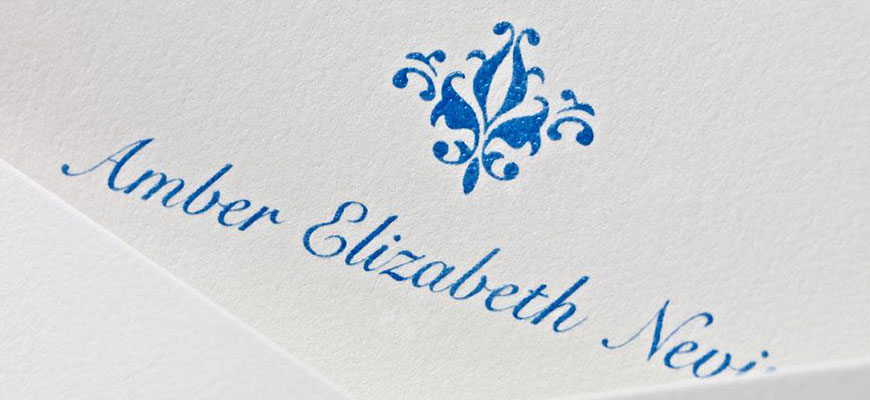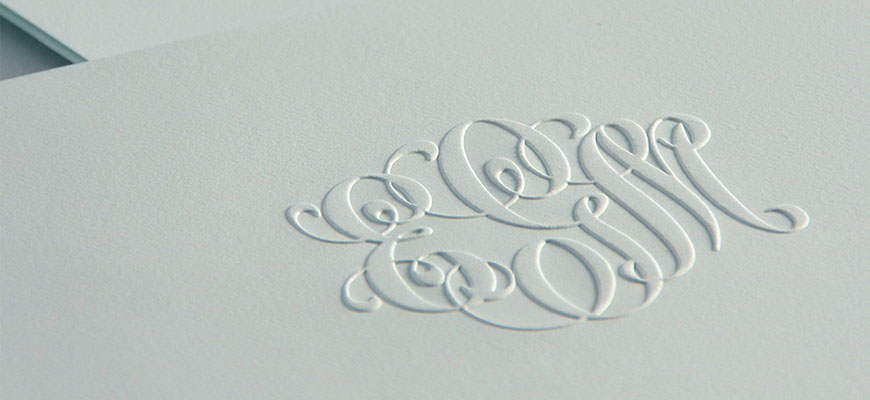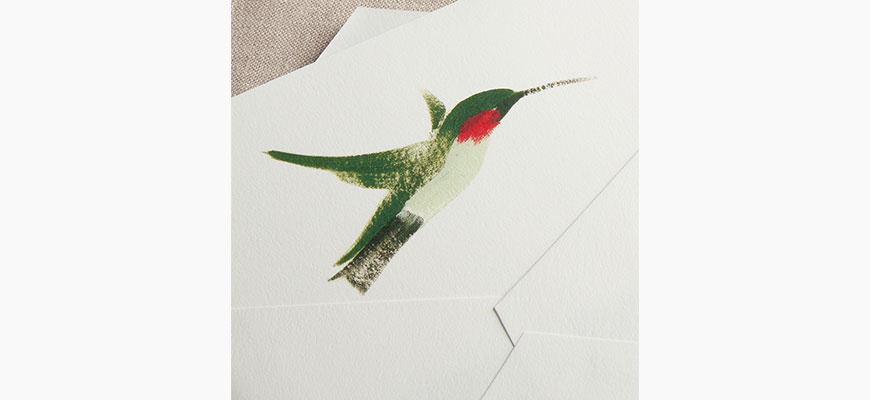There are many ways to put ink on paper. But aside from the overwhelming choices between colors, text and designs whizzing round your mind, there is a more fundamental decision to make: which printing process is right for your stationery?
At Crane we’ve created beautiful personalized stationery for everyone from the Roosevelts to current day style icons. Today we focus on creating characterful, timeless stationery for brides, businesses and families alike.
While the world has undoubtedly changed a little in the 200-plus years since we first put ink to paper, our dedication to printing excellence has held strong – whether we’re using the time-honored printing techniques of old, or developing the modern digital techniques of today.
Read on to find out more about the exquisite results that can come from the application of traditional and contemporary printing techniques and find the perfect printing process for your stationery or invitations.
Engraving: The Pinnacle of Style and Quality

Engraving sets the standard for print quality, and Crane sets the standard for engraving.
Our master engravers have honed their craft to perfection over decades of experience, building on the company’s centuries’ of history and knowledge to deliver quality craftsmanship, impeccable levels of service and stunning results that are, quite simply, on a level all of their own.
As a technique, engraving itself dates back to the 16th century. Engraved stationery has a warmth and elegance to it, along with a degree of detail unmatched by any other printing process.
Engraving creates finely detailed lettering and designs, with slight indentations on the reverse side of the paper; all conveying an unspoken message of timeless distinction.
Creating an engraved design is a highly detailed and time consuming process; our master engravers take great care to ensure every item we print meets our exacting standards. The essential steps are as follows.
- The professional engraver embarks on the process of die-stamping; using a pre-prepared die to transfer ink to paper.
- The die is placed on the press and a “counter” is cut to approximately the size of the area taken up by the engraved letters on the die. Ink is then applied to the die, where it settles in the engraved cavity but is wiped off other surfaces.
- The counter concentrates the pressure of the press on the area in which the image is to be engraved, forcing part of the paper into the etched cavity of the die, creating inked, raised surfaces in the paper.
The precision of aligning each additional printing layer requires highly specialized skill, learned over the lifelong careers of our master engravers.
Printing on colored paper and using white text? Engraving is an especially beautiful way to print these orders. Lustrous metallic inks such as gold, rose gold, platinum, and silver also appear best when engraved.
It is easy to tell whether a piece of stationery has been engraved. Just turn it over. If there is an indentation (caused by the pressure from the engraving press), it is engraved. You can also look closely at the impression on the front: the paper will be smoother and there may be a little ripple to the sheet.
It is used for all types of stationery. Simply put, by choosing engraving, you can be sure that it will be the finest quality. You can find exquisitely detailed boxed stationery sets that are perfect for all kinds of uses. Engraved personalized and business stationery is a classic choice that will always exude timeless good taste. Engraving is also a go-to for formal event invitations such as weddings, and in fact it is particularly well suited to grand social occasions.
Crane customers will receive the copper plate – or die – with their order which is yours to keep and treasure, and use for future orders.

Making the Die…
A die is a carefully crafted metal – at Crane we use copper dies – that has been formed to a specific design.
Here’s how a die is created:
- The desired text and design are typeset by computer before the printer transfers the design file and reproduces it as a “reverse” photographic image on a film negative.
- The film negative is placed on a chemically treated copper plate and the craftsman passes light through the film to expose the text image on the surface of the plate.
- By dipping the plate in acid, the exposed surface is chemically etched onto the copper plate, or die.
Thermography: Imitation is the Highest Form of Flattery
Sometimes referred to as “imitation engraving“, thermography produces an effect similar to engraving in that it can be felt on the surface of the paper.
However, it uses heat to create the letters and design rather than an engraved plate, so it is less expensive than engraving and generally faster.

While it doesn’t boast quite the kudos of engraved stationery, thermography still delivers a high-end and upmarket finish for distinguished personal and business stationery.
The printing process using thermography breaks down as follows:
- Thermography uses a resinous powder which is added to the printing ink.
- The expert printing professional then applies heat to the combined mixture and creates the specific design.
- This process of heating and drying the resinous powder and the printing ink results in a slightly raised effect on the paper – not dissimilar to the result of engraving.
Speed of delivery and price make thermography a natural choice for short-run business applications including business cards, marketing materials, announcements, programs, menu cards, invitations and envelopes.
On the personal side, thermography is also a popular choice for informal stationery, greeting cards, note cards, and invitations.
It offers a good trade-off between price and results for those who want to make an impression similar to that of engraving. It must be noted, however, that the two are not the same and without the engraving plate, lettering and designs printed in thermography lack some of the sharp definition, subtle degree of detail, and rich luster of engraving.


Thermography can be used in all kinds of stationery where an upmarket effect is desired but it is most commonly requested for:
- Invitations
- Certificates
- Letterheads
- A professional stationery wardrobe
Inkless Printing Techniques: Make an Impression
Engraving and thermography create some stunning effects but did you know printing presses can create equally beautiful – if very different – results without using any ink?
Both blind embossing and blind debossing use no ink during printing but instead use pressure to impress a design or message into paper.
Blind embossing features the image popping out of the paper, like Braille letters. Blind debossing, on the other hand, presses the image into the paper, like footprints in the sand.
Both can give printed pieces added depth and visual appeal and make a unique and beautiful statement on their own or when combined with ink printing techniques as part of a combined design.
Embossing

The simple, no-ink elegance of embossing contributes to its timeless appeal and makes it very easy to distinguish from other types of printing.
Embossing, or blind embossing, is similar to engraving in that a raised image is created by pressing paper onto a copper plate.
But unlike engraving, no ink is used in the process. Instead, the raised image stands on its own on the page, bringing an understated elegance and highly sophisticated look to the final product.
- For every embossed project, a master craftsman creates a one-of-a-kind die similar to an engraving plate, depicting the desired initials or image.
- A particularly high quality paper is selected – such as Crane’s beautiful, soft 100 percent cotton sheets. An exceptional paper is essential in securing the best quality final impression due to the nature of embossing as a printing process.
- The paper is pressed into the die and the stunning image is revealed. The technique can also cater to a multi-dimensional design, giving several steps or layers of depth, for a beautiful, rich effect.
Whether used alone or in conjunction with another ink-based printing technique, embossing can add an elegant, contemporary touch to all types of stationery.
Its subtlety lends itself well to business stationery, including letterhead and business cards. But it’s an equally excellent choice for adding family monograms or a coat of arms to personal stationery, such as correspondence cards or a wedding invitation for example.
No matter what use it’s put to, embossed stationery makes a sophisticated and subtle impression.
Debossing
Essentially the opposite of embossing, debossing involves pressing a design or lettering into the surface of paper, creating a recessed or sunken impression.
The results are just as subtle and distinguished as those of embossing and add an extra layer of texture and interest to your personalized stationery. So how does it work?
- As with an embossed design, a master craftsman creates a one-of-a-kind die similar to an engraving plate, depicting the desired initials or image.
- A particularly high quality paper is required here too to ensure the best final results – such as Crane’s beautiful, soft 100 percent cotton sheets.
- For debossing, the die is pressed into the paper, creating a relief of the design.
Debossing is not available on Crane’s personalized products but as a design element it’s one to look out for and understand where – and how – it has been applied in other products.
“An exceptional quality of paper is essential to assure the best quality print results from embossing and debossing.”
Letterpress
Wonderfully tactile and simply exquisite, letterpress printing has a rich, warm feel that one can’t help but appreciate. Developed in the 14th century, letterpress is a time-honored printing craft that – like engraving – takes years to perfect.
Colors appear deep and rich in tone, with a luxurious matte finish. The printing process is both time – and labor-intensive: prints are made one-at-a-time with each print having its own unique variations of ink coverage and depth of impression.
The result is truly handcrafted and worth the wait. But how does the process begin?
- To start, type and motifs are set in reverse on a letterpress plate.
- The plate is then inked and pressed onto the surface of a paper.
- The pressing process transfers the ink and leaves a deep impression on the paper creating a three-dimensional print that has a feel unlike any other type of printing.
The nature of the printing demands a high quality, and generally heavier weight paper that will not tear or thin when pressed.
Crane’s 100 percent cotton papers are ideal as the fibers contained within them are soft and readily accept an impression as well as ink. With an almost fabric-like softness, Crane’s Lettra paper is specifically designed to absorb the deep impressions of letterpress printing, making it the perfect choice.
Letterpress offers a contemporary sophistication that works on all types of stationery and invitations. It is a perfect option for featuring bolder font choices and designs rich in color. It is also ideal for less formal personalized stationery, wedding invitations, and business cards, where its tactile beauty is sure to make a lasting impression.

A truly handcrafted printing technique, letterpress printing requires exceptional skill.
It’s a wonderful choice of printing process to add an extra special finish to all kinds of stationery suited to heavier paper including:
- Wedding invitations
- Business cards
- Announcements
Digital Printing


Digital printing is what you’re doing in your office day in, day out, using a computer to print images directly from the computer onto the paper. But at a professional printing press, the printers take this technique to another level.
It’s a form of flat printing, which as the term implies, does not involve either raised or recessed designs but rather sees the images and lettering transferred directly onto the surface of the paper.
It’s a modern technique that has vastly expanded the color gamut and, when coupled with the best quality papers, delivers some incredible results.
The practicalities of the digital printing process are clear:
- Unlike traditional printing, digital printing sprays the ink directly onto the paper rather than imprinting it.
- The process starts with the computer design. Once this has been carefully laid out, it can be sent to the printer.
- The printer takes the design and, with a full understanding of the entire range of colors included, is able to create a remarkably accurate physical reproduction of the image.
As a result of the direct printing process, digital images tend to have a flat, one-dimensional appearance, which means they’re not ideal for every scenario.
However, for the right piece of stationery or design, the rich colors provided by a high-end printing system behind digital printing more than make up for the difference.
Digital printing is a fast, affordable method of printing ideal for full-color, short run projects, or for reproducing color and black-and-white photographs on cards, announcements and invitations.
No other printing method can match the crisp look and true color match that digital printing provides. However, the quality of the final product depends largely on the quality of the digital printer and paper used.
Crane’s high-end printers and premium papers render truly spectacular results.
Lithography
Lithography, also known as flat printing, is a printing technique well suited for large print runs, like some of our boxed stationery products.

The printing technique has an intriguing and varied history, but perhaps some of the most recognizable lithography prints are from Henri de Toulouse-Lautrec and his color lithography posters and prints that became iconic in Paris and later around the world.
Lithography is created as follows:
- Lithography is created by treating a plate with grease in the areas where no design is required.
- The plate is then applied to the paper.
- The greased areas will repel the ink and the ungreased areas will leave the mark of the desired image.
Lithography certainly has its place and is often used when printing in high quantities. It can be found on a range of boxed stationery options, and its uncomplicated nature makes it a generally more affordable option.
Foil Stamping
Shiny and lustrous, foil stamping can make a glittering impression for special projects. Whether it’s used alone or in conjunction with another printing process, foil stamping is all about adding that extra special sparkle to create an alluring combination of visuals and textures.
As a technique it relies on a combination of heat and pressure:
- First up, select your metal or colored material of choice! The most commonly associated color with foil stamping is gold, but other popular choices include rose gold, silver, black, and pearl white. Bold colors also make a stunning impression when foil stamped. Foil is also opaque, so it’s a great option for printing on colored papers.
- The foils are transferred through a heated stamping process onto paper.
- Metal dies heat up the foil and the pressure adheres the foil to the paper bringing your beautiful design ideas to life.
A little metallic sparkle can add a special touch to your invitations. Use it right and foil stamping will bring a unique subtle statement of individuality and creativity to your personalized invitations.

The sparkle makes foil stamping an obvious choice for festive occasions.
But used with care and incorporated into designs with subtlety, it’s an equally wonderful choice for wedding and event invitations and cards.
It can be found among the printing options for William Arthur and Vera Wang papers.
In Summary
Crane is proud to offer a full range of printing processes.
Over the years we have honed and perfected every tool and technique we need to craft the most stylish – and imaginative – personalized stationery at our customers’ request.
It’s all about taking that step away from the everyday.
Whether it’s a wedding invitation, social event, business fundraiser or a simple thank you note, leave your mark with expert printing craftsmanship from Crane.























I am looking for a store in Savannah or Charleston. I want engraved note cards and calling cards. I have my plate. Mary Sue Murray
I am looking for a custom sympathy card that we can print a small statement and about 40 names, with a simple elegant design. Are you able to do something like that?
What would be the lead time?
We have a very tight timeframe.
Thank you
Dear Crane. I would like to have a custom made logo almost close to a coat of arms on my daughter’s wedding invitation. I saw a graduation invitation with a crest or logo with gold and a royal blue color filled in the crest. Are you able to do this? I can take a picture and email it to you. I still have yet to design the final crest. It will probably be with the capital G for our last name GAMEZ. I do not want a Coat of Arms, more like a crest with fancy designs around the capital G. If you could be so kind to have your concierge service call me or send me the number where I can reach them. Do you also have samples of crest that you have used in the past? If you could be so kind to email or mail some samples. On invitation, I would like samples mailed to me so I can see the paper in person. I am thinking of a size of 6 3/4 X 9 1/2 invitation. The wedding will take place in October 29th, 2022 in San Antonio, Texas. My name is Cynthia Lee Gamez. mother of the bride. address 7030 Hathor Drive in Corpus Christi, Texas 78412. My cell, 361-442-4638, my email cindylgamez@gmail.com . Thank you, Cynthia Lee Fernandez Gamez
This is a fascinating description of the many types of Printing, embossing,-the many,many choices we have to choose from today for our personal stationary embellishments. Thank you.
Please send my wedding invitations that were ordered two months ago! I need to mail them now! It’s under the “You’re Invited” store order. Sarnicke/Andreini wedding. What is taking so long???
There is a typo on your site. On the “Our Printing Process” page, under “Engraving,” it says “company’s centuries'”. There shouldn’t be an apostrophe after “centuries.” By the way, I use your paper and I love it.
My daughter has picked out the different styles for her family.
I have a question – for her husband and her joint stationery – what is the difference between thermography and the next process. He is the Mayor of his city – and I think they should have an upgrade.
Her stationery and her 2 daughters have picked theirs out and sent to me the design. Could I attach images of what she wants and order online. I am out of the US and don’t return until the 23rd. So, I would like to order them earlier.
Thank you,
Joy Glass
Hello, can uoy make custom spring soirée invites? How fast is turnaround?
What are your “boxed products””